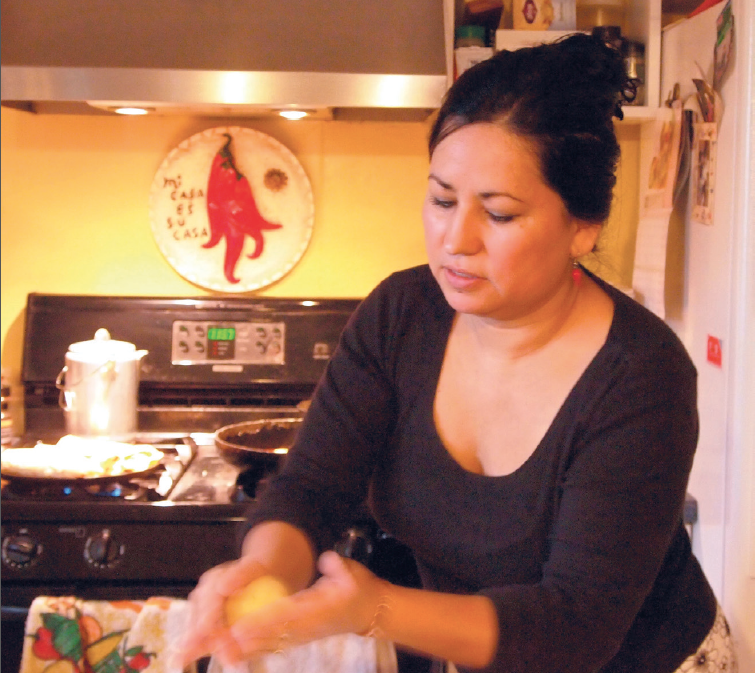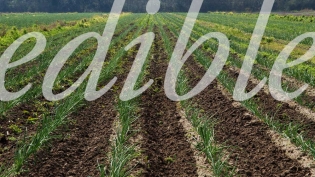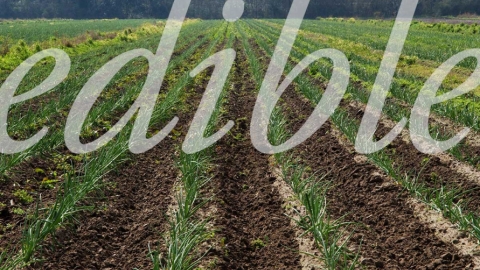Echoes of Home: Chihuahua, Mexico, to the Northeast Kingdom
“It’s my favorite spot,” Soledad Rodriguez de Adams says of her kitchen, which looks out toward Mount Mansfield from this southern end of Craftsbury. She holds her granddaughter, Amelia, in one arm and with the other, reaches for a spatula.
Today Chole, as she likes to be called, is cooking gorditas, literally “little fat ones.” The lightly fried corn tortillas are stuffed with beans, vegetables and sometimes meat. Chole’s gorditas are indeed hefty, filled with local vegetables—lettuce and tomatoes in the summer, potatoes and cabbage in the fall—and Chole (pronounced CHO-lay) spends several days each week preparing the components for these as well as the burritos, tamales and salsas she sells at the weekly Hardwick and Craftsbury farmers’ markets.
The traditional dishes she first learned to prepare by her mother’s side in Mexico have been varied slightly to make use of the bounty of vegetables from the garden behind the house, tended by her daughters Annie, 21 (Amelia’s mother), and Teresa, 12. For the ingredients they aren’t able to grow at home, Chole barters with market vendors, trading her home-cooked meals for the pasture-raised pork and beef she needs for her burritos, and certain vegetables that go into the gorditas.
Back home, Chole helped her grandfather sell elotes, the roasted corn on the cob dipped in cheese and served on a stick that are ubiquitous street food in Mexico. Here, Chole has been selling her own dishes for nearly a decade and recalls her intrigue upon first encountering the array of Vermont products at the markets.
“It was pretty neat to see what they made with the local produce,” she says, her deep, chestnut eyes smiling playfully at Amelia while she talks. Chole seems younger than her 45 years and, with skin that bears no trace of a wrinkle and silky black hair cascading down her back when it’s not pulled back in a bun, it’s hard to believe she’s a grandmother.
She describes being inspired by the local ingredients available to her in Vermont and improvising on her traditional Mexican dishes, sometimes substituting fresh cabbage for lettuce in the fall, adding potatoes to the burritos and gorditas when they’re first dug in the summer. Certain dishes, the burritos, for instance, she never prepared back home.
Growing up in Mexico, Chole explains, “We didn’t have much, and the stuff I cook with now, we wouldn’t have had in the house.” She says it’s been fun adapting the dishes she remembers from her childhood. “I just played here,” she said, explaining her initial surprise at how much was available to her. Compared to Mexican kitchens, it seemed like here, “even the poor people had everything.”
When I ask what goes into the green salsa that’s served as a condiment for everything she sells at market and can be purchased separately in eight-ounce jars, Chole gestures toward the counter piled with tomatillos, and the tomatoes, onions and cilantro from the garden. “Everything you need is there,” she tells me. Recipes are nowhere to be found in this kitchen and Chole’s daughters have learned to cook the same way their mother first did in Mexico. “I watched,” she tells me. “That’s the culture. Nobody teaches you,” she says, handing baby Amelia to Teresa, who’s come into the kitchen.
“I do the chopping,” Teresa explains. “The tomatoes, the onions, whatever she needs.” Teresa also helps her mother set up on market days. Annie, meanwhile, makes tacos every week to sell at the Art House on Craftsbury Common. Chole’s oldest daughter also works in the kitchen at Sterling College, where she sometimes prepares the foods she learned from her mother. “Annie can make everything my mom makes,” Teresa says, placing Amelia into her high chair. “Only maybe not as good.”
“She’s always calling me,” Chole says of Annie, who sometimes needs guidance with a particular dish. Even Tomás, Chole’s oldest at 25, likes to cook. “He makes good guacamole,” his mother says.
Chole breaks a just-cooked golden gordita into tiny bits and begins to feed Amelia. “Esta niña,” she coos, “this little girl, she likes my gorditas.” When I ask about her own grandmother, still living in Mexico, she says, “There was always food in the pot, always cousins, always people coming by.” It’s different in the United States, of course, where busy work schedules aren’t conducive to the more drawn-out rituals around the table back home. Chole admits it was hard at first being the only one of her eight siblings in the States, while the cold weather in particular took time getting used to. But she’s grown to love Vermont and explains it’s not easy for her to leave the state now. “It feels like home,” she says.
Indeed, we could almost be somewhere other than Vermont, surrounded by the Mexican pottery adorning the walls; the sweet, earthy smell of ground corn filling the kitchen; and three generations of females presiding over the cooking, chopping and, in little Amelia’s case, eagerly stuffing bits of warm gordita shell into her mouth. Chole says her children have learned to value the same things her parents imparted to her growing up—in particular, the honesty and hospitality of the people.
“You always offer something,” she explains, when someone comes to the house. “In Mexico, we always had tortillas.” Likewise, in her Craftsbury kitchen, there’s a stack by the stove, next to the plate of gordita shells, bowls of chopped cabbage and cilantro and a pile of freshly picked mushrooms—shaggy manes her husband, Ray, collected from the yard. These will be sautéed and served with the gorditas or put on pizza that will be made later.
And when the family can eat no more and the guests have been fed? Chole brings her food to the area’s immigrant farm workers, men and women from places like Mexico and Guatemala. They buy her market leftovers, if any, on Fridays and Saturdays. But sometimes, Chole says, “I make them a meal, just because.” She tells them, “You are in America; you have to eat a lot.”






